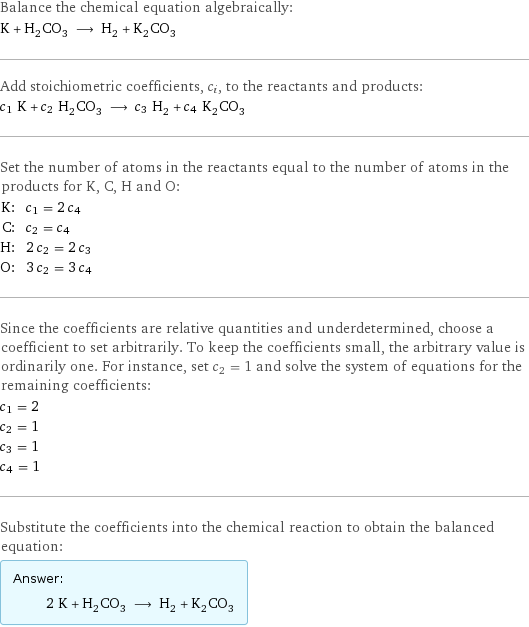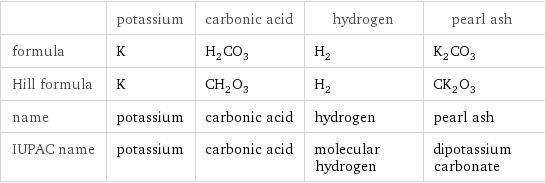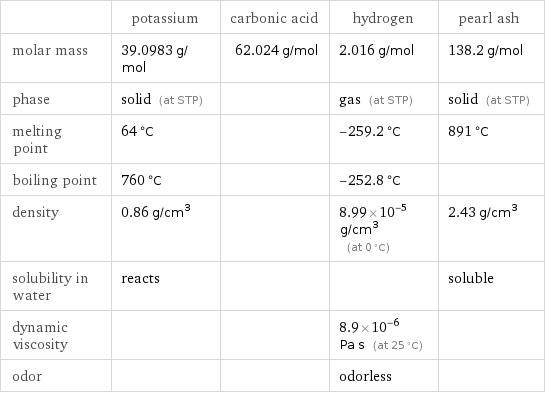Input interpretation

K potassium + H_2CO_3 carbonic acid ⟶ H_2 hydrogen + K_2CO_3 pearl ash
Balanced equation

Balance the chemical equation algebraically: K + H_2CO_3 ⟶ H_2 + K_2CO_3 Add stoichiometric coefficients, c_i, to the reactants and products: c_1 K + c_2 H_2CO_3 ⟶ c_3 H_2 + c_4 K_2CO_3 Set the number of atoms in the reactants equal to the number of atoms in the products for K, C, H and O: K: | c_1 = 2 c_4 C: | c_2 = c_4 H: | 2 c_2 = 2 c_3 O: | 3 c_2 = 3 c_4 Since the coefficients are relative quantities and underdetermined, choose a coefficient to set arbitrarily. To keep the coefficients small, the arbitrary value is ordinarily one. For instance, set c_2 = 1 and solve the system of equations for the remaining coefficients: c_1 = 2 c_2 = 1 c_3 = 1 c_4 = 1 Substitute the coefficients into the chemical reaction to obtain the balanced equation: Answer: | | 2 K + H_2CO_3 ⟶ H_2 + K_2CO_3
Structures

+ ⟶ +
Names

potassium + carbonic acid ⟶ hydrogen + pearl ash
Equilibrium constant
![K_c = ([H2] [K2CO3])/([K]^2 [H2CO3])](../image_source/d46b64e6b42258f3a3f9bbc66ef7c222.png)
K_c = ([H2] [K2CO3])/([K]^2 [H2CO3])
Rate of reaction
![rate = -1/2 (Δ[K])/(Δt) = -(Δ[H2CO3])/(Δt) = (Δ[H2])/(Δt) = (Δ[K2CO3])/(Δt) (assuming constant volume and no accumulation of intermediates or side products)](../image_source/c9595df38add3e4f8fc7928c13457aa4.png)
rate = -1/2 (Δ[K])/(Δt) = -(Δ[H2CO3])/(Δt) = (Δ[H2])/(Δt) = (Δ[K2CO3])/(Δt) (assuming constant volume and no accumulation of intermediates or side products)
Chemical names and formulas

| potassium | carbonic acid | hydrogen | pearl ash formula | K | H_2CO_3 | H_2 | K_2CO_3 Hill formula | K | CH_2O_3 | H_2 | CK_2O_3 name | potassium | carbonic acid | hydrogen | pearl ash IUPAC name | potassium | carbonic acid | molecular hydrogen | dipotassium carbonate
Substance properties

| potassium | carbonic acid | hydrogen | pearl ash molar mass | 39.0983 g/mol | 62.024 g/mol | 2.016 g/mol | 138.2 g/mol phase | solid (at STP) | | gas (at STP) | solid (at STP) melting point | 64 °C | | -259.2 °C | 891 °C boiling point | 760 °C | | -252.8 °C | density | 0.86 g/cm^3 | | 8.99×10^-5 g/cm^3 (at 0 °C) | 2.43 g/cm^3 solubility in water | reacts | | | soluble dynamic viscosity | | | 8.9×10^-6 Pa s (at 25 °C) | odor | | | odorless |
Units
